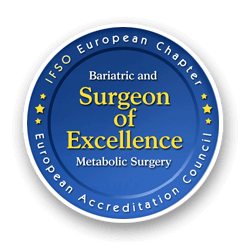
Oesophageal surgeries
Ivor Lewis Oesophagectomy – Oesophageal Cancer
Ivor Lewis Oesophagectomy – Oesophageal Cancer
The operation includes 2 individual procedures, one in the abdomen and the other in the thorax. The first consists of laparoscopically mobilizing the stomach and abdominal part of the oesophagus. In the 2nd stage a thoracotomy is performed on the right side of the chest and the thoracic part of the oesophagus is mobilised, the resection is carried out followed by anastomosis of the oesophagus with the stomach.
Oesophagectomy is the removal of most of the oesophagus.
The main function of the oesophagus is to transfer food from the mouth to the stomach.
After removing the section, the two ends are joined together again (anastomosis) which means most of the stomach will be positioned higher inside the chest than before, but it will function almost normally.
The amount of oesophagus that is removed depends on the size and location of the cancer.
McKewon Oesophagectomy – Oesophageal Cancer
McKewon Oesophagectomy – Oesophageal Cancer
The operation consists of 3 individual procedures, where incisions are made in the abdomen, thorax and the left side of the neck. In the first, the stomach and abdominal oesophagus are mobilised. In the second stage, thoracotomy is performed and the thoracic oesophagus is mobilised. Finally, in the third procedure the cervical oesophagus is mobilised followed by resection and then anastomosis of the oesophagus with the stomach.
The term “radical oesophageal resection” describes the removal of lymph nodes around the stomach and oesophagus.
Surgical treatment of oesophageal cancer generally involves a radical oesophagectomy.
The type of oesophagectomy performed on each patient is mainly determined by the location of the tumour or disease.
An oesophagectomy is a major operation and can take from five to ten hours.
Anaesthesia and surgery are complex and require a specialist anaesthesiologist and a team of surgeons to perform.
The goal of surgery is to remove the tumour with clear healthy boundaries.
The removed tissue, including the lymph nodes, is sent for histopathological evaluation.
The results of these tests are usually ready within 5 – 7 days.
Oesophageal Achalasia
Oesophageal Achalasia
This is a disorder of the oesophagus that affects the descent of food into the stomach, due to a lack of the necessary wave-like elasticity of the oesophagus.
The patient is admitted either into a private clinic or a hospital.
Before the operation the patient needs to go to the clinic or hospital a few hours earlier.
A few days earlier the patient attends an appointment for blood samples, examination by the team of any specialties deemed necessary by the anaesthesiologist, as well as by the physiotherapy department.
The average length of stay is about 7-10 days after surgery.
One to three days will be spent in the intensive care unit.
The patient may also be intubated for a few hours after the operation, but there should be no concerns, because the tubes will be removed quickly, if all is well. The patient will be drowsy that evening and therefore will not remember much, including visitors.
For the first week, the patient will be hydrated intravenously.
A nasogastric tube is placed so as to keep the stomach empty.
A chest drainage tube will be placed on the right side of the chest, helping the full expansion and function of the lung, and will be removed on the 5th day after the operation, which is when the integrity of the anastomosis is checked.
Pain is adequately controlled with the help of an epidural, which will remain in place for about 5 days. The above are all removed one by one, depending on the patient’s progress and recovery.
After 5 days, the integrity of the anastomosis is checked by oral administration of a blue dye or a contrast agent together with an X-ray.
Both of these tests allow the surgeon to determine if the anastomosis has adequately healed and that the seal is complete.
If it has sealed, then gradual hydration by mouth begins.
If there is a delay in the healing of the anastomosis then the introduction of fluids and food will be delayed.
The physiotherapist will help every day, and will encourage you to breathe deeply and do coughing exercises, as well as mobilization exercises. This is the most important thing that can be done to speed up recovery and prevent pneumonia.
The sutures are removed when you are discharged, as their removal coincides with complete recovery.
Hiatal Hernia – Gastro-Oesophageal Reflux Disease (GERD) – Tholoplasty procedures
Hiatal Hernia – Gastro-Oesophageal Reflux Disease (GERD) – Tholoplasty procedures
Gastroesophageal reflux disease (GERD) affects about 10% of the population and is usually due to the presence of a hiatal hernia.
The most common form of hiatal hernia is called a “sliding hiatal hernia.”
A hiatal hernia is caused by a loosening or an anatomical anomaly where the normal opening of the diaphragm (foramen) becomes enlarged. This is the opening through which the oesophagus passes from the thorax to the abdomen and joins the stomach.
The relaxation or widening of this opening, whether acquired or genetic, allows the stomach to move upwards into the chest cavity.
If the stomach and the abdominal part of the oesophagus are circularly mobilized and move backward towards the chest, this type of hiatal hernia is called ‘sliding’.
If the stomach slides, despite a relatively immobile and fixed oesophagus inside the chest, the hiatal hernia is called a paraesophageal hernia.
This type of hiatal hernia is not very common, but if left untreated, it can cause severe damage to the top of the stomach.
Gastroesophageal reflux involves the movement of gastric fluid upward into the oesophagus due to weakness in a muscular ring called the cardioesophageal sphincter which functionally isolates the two organs (oesophagus and stomach) during the process of digestion.
It is often due to the presence of a hiatal hernia, which has gone unnoticed.
The reflux of fluid (acids) into the oesophagus is continuous and does NOT cause symptoms for a long time.
Over time, however, it causes oesophagitis (inflammation of the lining of the oesophagus) that manifests itself in a burning sensation behind the breastbone in the area of the heart, what we commonly call “heartburn”.
This “heartburn” is often described as an acute burning sensation in the area between your ribs or just below the neck.
Many adults experience this unpleasant feeling at least once a month.
Other symptoms may include vomiting, difficulty swallowing and a chronic cough or asthma.
The following video shows the tholoplasty (fundoplication) procedure:
© 2022 BariatricSC. All Rights Reserved. | Privacy Policy | Terms of Use Created by BeCulture
Would you like to make an appointment?
Get in touch







